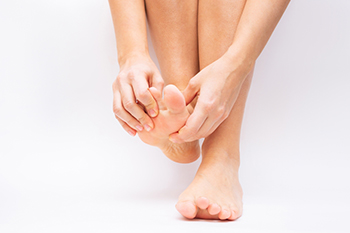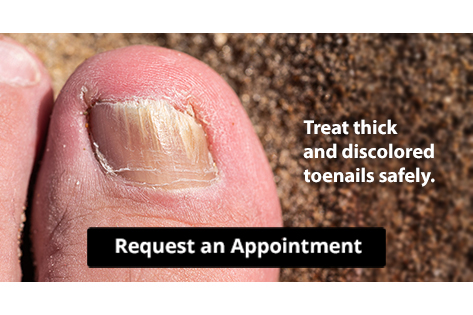Items filtered by date: August 2024
Risks of Ankle Sprains and Strains

Ankle sprains are common injuries, but certain factors can increase the risk. Engaging in physical activities without proper conditioning, such as skipping, stretching, and strengthening exercises, can put added strain on the ligaments in your ankle. Muscle and ligament fatigue, especially when pushing through the final stages of a rigorous activity, can also heighten vulnerability to injury. Failing to warm up properly before exercise is another risk, as tight muscles and ligaments are more prone to injury. Carrying excess weight also places extra stress on your joints and increases the chances of ligament or muscle damage. Gender and age play roles, too, with women over 30 and young males aged 15 to 24 showing a higher incidence of ankle sprains. Wearing inappropriate shoes, such as high heels on uneven surfaces or low-topped shoes during sports, also contributes to risk. If you have a history of ankle injuries, your likelihood of re-injury increases. If you have sustained an ankle injury, it is suggested that you schedule an appointment with a chiropodist for guidance.
When one or more ligaments in the ankle overstretch or tear due to injury, an ankle sprain occurs. If you would like to learn more about ankle sprains, please consult with Cynthia Chan, B.Sc., D.Ch from Healthy Advantage Foot & Orthotic Clinic. Our practitioner can help you maintain the health of your lower limbs and your mobility.
Symptoms of an ankle sprain vary depending on the severity of the injury, but may include:
Pain
Swelling
Bruising
Tenderness
Difficulty walking
Ankle instability
A reduced range of motion in the ankle
Treatments for an ankle sprain may consist of:
Resting the injured ankle
Applying ice
Elevating the ankle
Compressing the ankle
Over-the-counter pain medications
Ankle braces or other devices to take weight off of the ankle
Ankle exercises
Surgery (in rare cases)
It’s important for the sprained ankle to heal correctly and fully in order to avoid repeated injury. If you have any questions, please feel free to contact our office located in . We offer the newest diagnostic and treatment technologies for all your foot care needs.
Causes and Concerns of Wide Feet

Wide feet can be a source of discomfort, particularly when ill-fitting shoes are involved. Several factors contribute to having wide feet. Genetics play a significant role as some individuals are simply born with a broader foot structure, often associated with flat feet. When people age, ligaments and tendons loosen, potentially causing the foot to widen. Pregnancy can also lead to wider feet due to hormonal changes that relax the ligaments. Foot deformities, such as bunions and calluses, and conditions like edema can also increase foot width. Wearing shoes that do not properly accommodate wide feet can lead to painful issues, including bunions, calluses, and hammer toes. Seeking footwear with ample width and a roomy toe box can alleviate some of these concerns. A chiropodist can help identify and address any underlying issues related to abnormal foot width. If you have foot pain related to wide feet, it is suggested that you schedule an appointment with a chiropodist for advice.
The biomechanics of your feet play an important role in your foot health. To learn more, please consult with Cynthia Chan, B.Sc., D.Ch from Healthy Advantage Foot & Orthotic Clinic. Our practitioner can help you maintain the health of your lower limbs and your mobility.
Foot biomechanics refers to the study of the structure, function, and motion of the feet. The feet and ankles are a complex system consisting of many bones, joints, ligaments, muscles, and tendons that work together to move your feet. Understanding the unique biomechanics of your own feet can help you and your chiropodist make informed decisions about your foot health care. This includes decisions about the best preventive measures to avoid foot pain, the best treatment options for various foot problems, and finding the best shoes for your feet.
If you have any questions, please feel free to contact our office located in . We offer the newest diagnostic and treatment technologies for all your foot care needs.
Causes of Pain in the Big Toe

Big toe pain can stem from various causes that significantly affect your daily activities and overall comfort. One common cause of big toe pain is injury, particularly in athletes who might sprain, bruise, or even fracture their big toe. Osteoarthritis, common in middle-aged and elderly individuals, leads to joint pain and stiffness. Rheumatoid arthritis causes severe inflammation and potential toe deformities. Bunions, often worsened by wearing tight footwear, enlarge the base of the toe, causing considerable discomfort. Gout, a form of arthritis due to high uric acid levels, frequently affects the big toe, resulting in acute pain and inflammation. Additionally, Raynaud phenomenon, triggered by cold exposure, constricts blood vessels, leading to soreness. A chiropodist can diagnose the big toe to determine the cause and how to manage it. If your big toe hurts, it is suggested that you schedule an appointment with a chiropodist for a diagnosis and treatment solutions.
Toe pain is common and can have a variety of causes. Causes can range from a broken toe to an ingrown toenail. Many types of toe pain can be corrected, but any toe pain that inhibits your activities for an extended period should be discussed with a chiropodist. If you suffer from toe pain, please consult with Cynthia Chan, B.Sc., D.Ch from Healthy Advantage Foot & Orthotic Clinic. Our practitioner can help you maintain the health of your feet.
Common Causes of Toe Pain
- Trauma or fracture
- Cuts, sores, or bruises
- Rheumatoid arthritis
- Gout
- Turf Toe
- Morton’s neuroma
- Blisters
- Corns
- Bunions
- Hammertoes
- Ingrown toenails
- Plantar warts
- Athlete’s Foot
Symptoms of Toe Pain
- Toe deformity
- Burning
- Numbness
- Toenail deformity
- Wart or ulcer
- Swelling
- Redness
When to See a Chiropodist
- Bleeding or severe swelling
- Trauma, such as a broken bone
- Discoloration or extreme swelling
- Inability to bear weight
- Persistent pain
- Wounds that won’t heal
Diagnosis of Toe Pain
A chiropodist can conduct a thorough examination of the painful toe or toes in order to determine the best course of treatment. The exam may include assessing the tenderness of the area, taking an X-ray or other diagnostic test, or assessing your gait and range of motion. A discussion of what led to the advanced pain issue may follow. Included will likely be a health history, as well as a list of medications you are taking and other previous injuries you may have sustained.
Treatment for Toe Pain
With such a wide range of possible causes for toe pain, treatment can be varied in scope and length. Sometimes, the chiropodist will recommend lifestyle and activity changes. In cases of trauma or other injuries, X-rays or imaging tests will likely be used to determine the severity of the problem, particularly if any bones have been broken. Treatment may also include injections of pain-relief medication or anti-inflammatory drugs. Certain injuries will require the splinting, bracing, or wrapping of injured toes. Orthotics or special shoes may be prescribed in cases of bone deformities and gait issues. Removal of warts, calluses, and corns may be needed. In other cases, such as with patients who have diabetes or rheumatoid arthritis, ongoing treatment may be required to avoid more serious problems.
Stop Your Toenail Fungus
What to Do About Foot Pain

Foot pain can arise from various conditions, each requiring different management strategies. Plantar fasciitis, characterized by heel pain, occurs due to inflammation of the plantar fascia. Relief can come from practicing stretching exercises, wearing proper footwear, and orthotics that can provide arch support. Achilles tendinitis causes pain at the back of the heel, often due to overuse. Rest and calf stretches can reduce inflammation. Metatarsalgia, or pain in the ball of the foot, typically results from high-impact activities or wearing ill-fitting shoes. Cushioning insoles and avoiding high heels can alleviate discomfort. Bunions, painful bony bumps on the side of the foot, often result from wearing tight shoes. Switching to wider footwear and using bunion pads can help. For general foot pain, maintaining a healthy weight, wearing supportive shoes, and practicing good foot hygiene are important. If you suffer from persistent or severe foot pain, it is suggested that you consult with a chiropodist, who can provide a thorough diagnosis and recommend a tailored treatment plan to address the underlying cause effectively.
Foot pain can have many causes. To receive an accurate diagnosis and treatment for your foot pain, please consult with Cynthia Chan, B.Sc., D.Ch from Healthy Advantage Foot & Orthotic Clinic. Our practitioner will assess your condition and provide you with quality foot and ankle treatment.
Causes
There are a variety of different conditions that can cause foot pain, including:
Plantar fasciitis
Deformities, such as bunions or hammertoes
Injuries to the muscles, bones, tendons, or ligaments in the feet
Arthritis
Flat feet
Ingrown toenails
Symptoms
The type and location of your foot pain can help determine what may be causing it and what type of treatment options are best for you.
Common types of foot pain include:
Heel pain
Arch pain
Toe pain
Ball of foot pain
Pain that has a stabbing, burning, or tingling quality
Pain that is constant, intermittent, or that gets better or worse depending on the situation
Diagnosis
A thorough medical history and physical examination of your feet will be required to determine a diagnosis. Imaging studies, such as X-rays or MRIs may be performed to rule out or confirm certain diagnoses.
Treatment
Treatment will depend on the cause of the pain. Common treatments for foot pain include resting, icing, compressing, and elevating the affected foot, wearing orthotics, or taking anti-inflammatory medications.
If you have any questions, please feel free to contact our office located in . We offer the newest diagnostic and treatment technologies for all your foot care needs.
